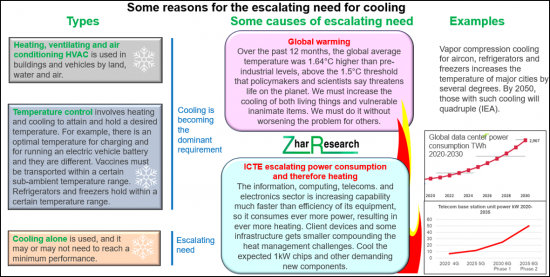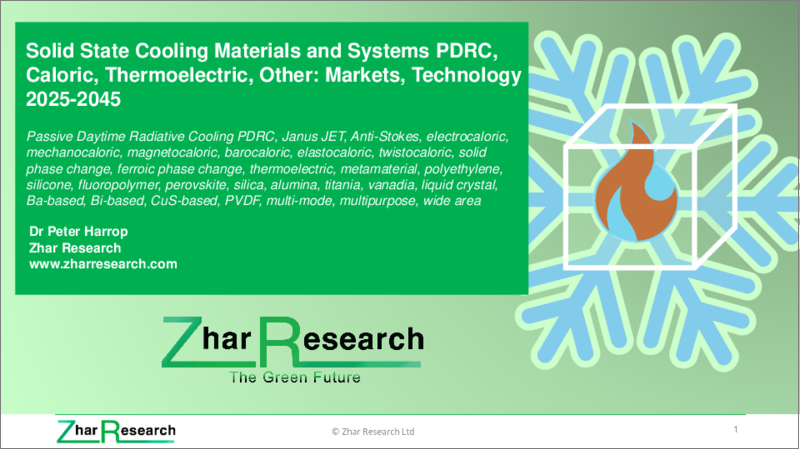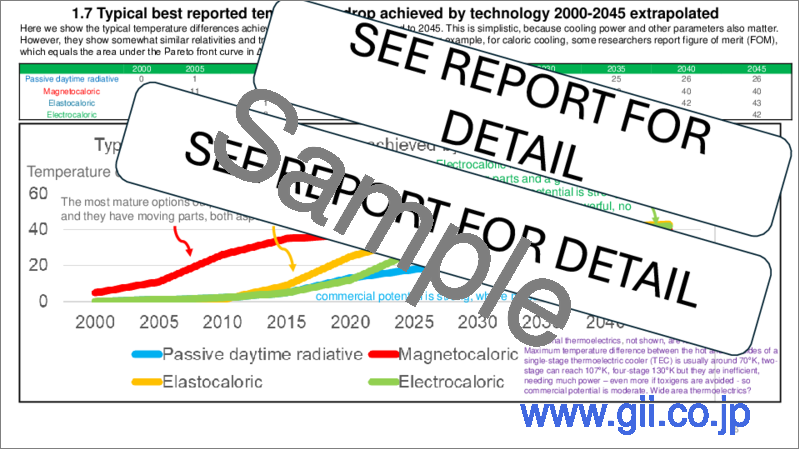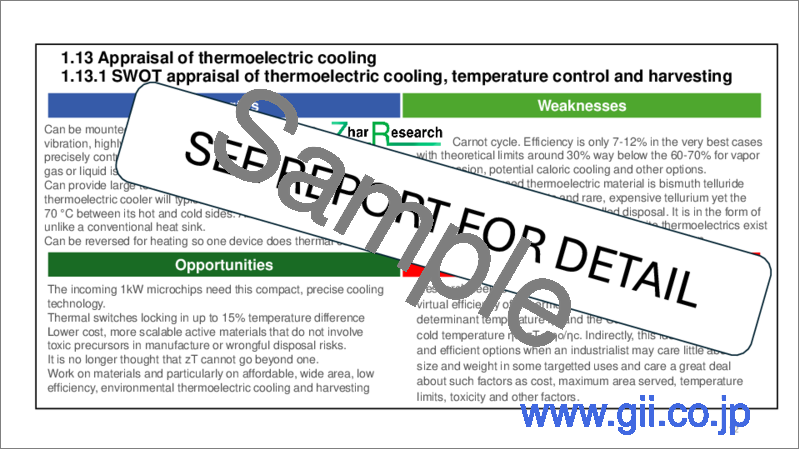|
|
市場調査レポート
商品コード
1563423
固体冷却材料およびシステム (PDRC・カロリック・熱電・その他) の市場と技術 (2025-2045年)Solid State Cooling Materials and Systems PDRC, Caloric, Thermoelectric, Other: Markets, Technology 2025-2045 |
||||||
|
|||||||
| 固体冷却材料およびシステム (PDRC・カロリック・熱電・その他) の市場と技術 (2025-2045年) |
|
出版日: 2024年09月25日
発行: Zhar Research
ページ情報: 英文 339 Pages
納期: 即日から翌営業日
|
- 全表示
- 概要
- 目次
支配的位置付けの蒸気圧縮冷却は今後S字カーブを避けられず、20年以内に急激にシェアを落とす見通しです。その前の10年以内に、多く固体冷却の新興企業がシェアを拡大し、冷却大手に買収される見通しであり、投資家にとっては絶好の出口となるでしょう。
固体冷却は、1kWマイクロチップの登場、より高温の6G通信インフラの計画、次世代フレキシブルソーラーパネル、さらには致死的な50℃の夏でもよく冷える衣服の登場など、冷却に対する多くの新しいニーズに対応する見通しです。固体冷却は、構造エレクトロニクスを含む多機能スマート素材へのトレンドの一部となっています。

当レポートでは、固体冷却材料およびシステムの市場を調査し、新しい固体冷却技術の概要、主要材料のR&D動向、技術ロードマップ、主要材料の市場規模の推移・予測、ケーススタディ、参入事業者、事業機会の分析などをまとめています。
目次
第1章 エグゼクティブサマリー・結論
- 本レポートの目的
- 調査手法
- 冷却の必要性が高まる多くの理由
- 固体冷却の性質とそれが今優先事項である理由
- 冷却ツールキット、多機能化の傾向、最高の固体冷却ツール
- 18の主な結論
- 主要な気温低下技術:2000~2045年
- 重要なカロリック冷却研究の数:技術別
- 固体冷却の研究における主要材料
- PDRCの評価
- 電気カロリック冷却の評価
- 弾性熱量冷却の評価
- 熱電冷却の評価
- 冷却ロードマップ:市場・技術別
- 市場予測
- 背景予測
第2章 イントロダクション
- 概要
- 冷却の必要性は、はるかに大きくなり性質も異なることが多い
- 冷却要件の大きな変化の例:2025~2045年
- 冷却技術はスマート材料にどのように移行するか
- エアコンの省電力、環境に優しく、手頃な価格に再発明
- 広く使用され、提案されている望ましくない材料:これはあなたにとっての機会です
- 2024年に発表された固体冷却の競合の例
第3章 PDRC (Passive Daytime Radiative Cooling)
- 概要
- PDRCの基礎
- 構造・構成による放射冷却材料
- 潜在的な利点と応用
- 2024・2023年のその他の重要な進歩
- PDRCを商業化する企業
- 3M USA
- BASF Germany
- i2Cool USA
- LifeLabs USA
- Plasmonics USA
- Radicool Japan, Malaysia etc.
- SkyCool Systems USA
- SolCold Israel
- Spinoff from University of Massachusetts Amherst USA
- SRI USA
- PDRC SWOTレポート
第4章 自己適応型・切り替え可能・調整可能・ヤヌス型・反ストークス型の固体冷却
- 全体像の概観・SWOT
- 放射冷却技術の成熟曲線
- 自己適応型で切り替え可能な放射冷却
- 両側を利用した調整放射冷却:SWOT評価
- 反ストークス蛍光冷却:SWOT評価
第5章 相変化・カロリック冷却
- 構造および強磁性相変化冷却モードと材料
- 固体相変化冷却:指定された用途において他の形式と競合する可能性がある
- カロリック冷却に関連する物理的原理
- カロリック冷却の動作原理
- 熱電冷却とカロリック冷却の比較と、優れたカロリック冷却技術の特定
- カロリック冷却の利用を促進するための研究提案
- 電気カロリック冷却
- 磁気カロリック冷却:SWOT評価
- 機械カロリック冷却 (弾性・圧・ねじれ)
- マルチカロリック冷却
第6章 実現技術:メタマテリアルおよびその他の先進的な光冷却:新興材料とデバイス
- メタマテリアル
- 高度な光子冷却と加熱防止
第7章 他の固体冷却のユーザーおよび電力供給者としての将来の熱電冷却と熱電発電
- 基礎
- 熱電材料
- 広範囲かつ柔軟な熱電冷却:取り組むべき市場のギャップ
- 建物の放射冷却:2024年に熱電発電により多機能化
- TECとTEGの熱除去問題:進化するソリューション
- 熱電冷却と冷却を伴う発電における20の進歩と2024年のレビュー
- 2023年の進歩
- ペルチェ熱電モジュールおよび製品の製造業者82社
Summary
Solid state cooling is now a superb investment with impressive research advances through 2024. Uniquely, the new Zhar Research report, "Solid State Cooling Materials and Systems PDRC, Caloric, Thermoelectric, Other: Markets, Technology 2025-2045" gives that new picture with PhD level analysis.
Shake up
Nothing is forever and the dominant vapor compression cooling will be subject to the inevitable S curve, sharply losing share within 20 years. Long before that, within ten years, many solid-state cooling startups starting to take share will be bought by the cooling giants playing catch-up, this providing an excellent exit for investors.
Serving new needs
Solid-state cooling will serve the many new needs for cooling such as 1kW microchips arriving, planned hotter 6G Communications infrastructure, next generation flexible solar panels and even apparel that cools well in the lethal 50C summers arriving. Solid-state cooling is part of the trend to multifunctional smart materials including structural electronics: vapor compression is not.
Latest research is important
This commercially-oriented 339-page report has 292 research advances assessed from 2024 and 2023, 102 companies mentioned, ten SWOT appraisals, 33 new infograms, 17 forecast lines 2025-2045. The primary focus is on the technologies judged to have the largest commercial potential 2025-2045 - radiative cooling into the atmospheric window, notably the variant called passive daytime radiative cooling, the many forms of caloric cooling and thermoelectric cooling being reinvented. Multi-mode and multifunctional forms are revealed and new enabling technologies such as metamaterial cooling explained.
Lucid insights
The 30-page Executive Summary and Conclusions is sufficient in itself, presenting roadmaps 2025-2045, those 17 forecast lines, many new pie charts, comparisons, SWOTs, radical new needs. See projections such as best cooling temperature differences and cooling power achievements likely 2025-2045 by technology. Which two caloric cooling technologies win? See the most promising materials for each technology ranked from research and latest company initiatives and some toxigen issues that are an opportunity for you.
The 26-page Introduction puts it in context such as emerging countries such as Saudi Arabia and India being in hotter locations just as global warning is added. See the new cooling needs from ever hotter microchips graphed, telecommunications base station and data center power escalation graphed. Here are the allied technologies such as thermal conductors shown in maturity curves 2025, 2035, 2045 and the solid-state cooling options they support. See how the need for vapor compression will be eased by adding some of the new technologies. However, this is an unbiassed report, so the chapter ends with detail on two examples of competition for solid state cooling that emerged in 2024. The rest of the report is much more detailed with two chapters on different forms of radiative cooling, one on the enabling metamaterials, one on caloric cooling and one on emerging new forms of thermoelectric cooling.
Chapter 3 "Passive Daylight Radiative Cooling" takes 98 pages, massively important because, taking no power, it is easily integrated into apparel and buildings. This technology combines radiative cooling into the atmospheric window with reflection of heat. Exactly how does it work in structures and fabrics? Smart windows, invisible facades and remarkable other applications being progressed? See how ten companies commercialising PDRC. The materials involved are very closely examined. Can it be coloured without compromise? Transparent, aerogel, porous, ceramic and meta-material forms? Overall, the 13 most important formulations of material for PDRC are prioritised, particularly incorporating the research breakthroughs in 2024.
Chapter 4 (30 pages) takes you into allied technologies and advanced functionalities of PDRC with, "Self-adaptive, switchable, tuned, Janus and anti-Stokes solid state cooling". This includes two-way radiative cooling, use of fluorescence and different materials such as vanadium salts and liquid crystal. As with all the other chapters, enjoy SWOT appraisals, diagrams and analysis, not rambling text.
Chapter 5, "Phase change and particularly caloric cooling" compares the cooling obtained by phase changes between solid, liquid and gas and the feeble cooling between different solid crystalline states. However, this chapter then almost entirely focuses on the exciting solid-state one - caloric cooling by alteration of ferroic state. See magnetocaloric, elastocaloric, twistocaloric, barocaloric and electrocaloric compared and why an additional liquid option is not promising. Learn how latest research leads us to look particularly closely at the complementary technologies electrocaloric and elastocaloric, the winning materials from latest research and the issues to overcome before successful commercialisation such as sometimes toxigen intermediaries, moving parts or high voltages. Nonetheless, the potential on a 20-year view is shown to be considerable.
In a report on solid state cooling, thermoelectrics might seem the dullest option - mature yet only achieving a market size of around one billion dollars. However, the closer look in this report reveals that this huge and precise cooling capacity even on a tiny scale is badly needed for some new needs. Learn how it can be boosted by using some of the other solid state cooling options on the hot side. In addition, see how wide area, low-cost thermoelectrics is a real, though not immediate, possibility when latest research is appraised in detail. This chapter 7, "Future thermoelectric cooling and thermoelectric harvesting as a user of and power provider for other solid-state cooling" (72 pages) ends with 82 manufacturers listed.
Zhar Research report, "Solid State Cooling Materials and Systems PDRC, Caloric, Thermoelectric, Other: Markets, Technology 2025-2045" is essential reading for those seeking to make or use the next generation of cooling technology and all in added value materials that seek large new opportunities.
CAPTION: Some reasons for the escalating need for cooling. Source, Zhar Research report, "Solid State Cooling Materials and Systems PDRC, Caloric, Thermoelectric, Other: Markets, Technology 2025-2045".

Table of Contents
1. Executive summary and conclusions
- 1.1. Purpose of this report
- 1.2. Methodology of this analysis
- 1.3. The many reasons for the escalating need for cooling
- 1.4. The nature of solid-state cooling and why it is now a priority
- 1.5. Cooling toolkit, trend to multifunctionality with best solid-state cooling tools shown red
- 1.6. 18 Primary conclusions
- 1.7. Typical best reported temperature drop achieved by technology 2000-2045 extrapolated
- 1.8. Number of important caloric cooling research advances 2024 and 2023 by technology revealing best options
- 1.9. Leading materials in number of latest research advances on solid state cooling
- 1.10. Appraisal of Passive Daytime Radiative Cooling PDRC
- 1.10.1. SWOT appraisal of PDRC
- 1.10.2. Popularity of materials by family in recent research on PDRC and allied radiative cooling
- 1.11. Appraisal of electrocaloric cooling
- 1.11.1. SWOT appraisal of electrocaloric cooling
- 1.11.2. Electrocaloric materials by popularity in research
- 1.12. Appraisal of elastocaloric cooling
- 1.13. Appraisal of thermoelectric cooling
- 1.13.1. SWOT appraisal of thermoelectric cooling, temperature control and harvesting
- 1.13.2. Formulation popularity of latest thermoelectric cooling technology
- 1.14. Cooling roadmap by market and by technology 2025-2045
- 1.15. Market forecasts 2025-2045 as tables with graphs
- 1.15.1. Cooling module global market by seven technologies $ billion 2025-2045
- 1.15.2. Terrestrial radiative cooling performance in commercial products W/sq. m 2025-2045
- 1.16. Background forecasts
- 1.16.1. Air conditioner value market $ billion 2025-2045 and by region
- 1.16.2. Global market for HVAC, refrigerators, freezers, other cooling $ billion 2025-2045
- 1.16.3. Refrigerator and freezer value market $ billion 2025-2045
- 1.16.4. Market for 6G vs 5G in 2 categories base stations units millions yearly 2025-2045
2. Introduction
- 2.1. Overview
- 2.2. Need for cooling becomes much larger and often different in nature
- 2.3. Examples of radical changes in the requirements for cooling 2025-2045
- 2.3.1. Escalation of demand for air conditioning and forthcoming changes in requirement
- 2.3.2. How 6G Communications from 2030 will bring new cooling requirements: infograms
- 2.3.3. Severe new microchip cooling requirements arriving
- 2.3.4. Other cooling problems and opportunities emerging in electronics and ICT
- 2.4. How cooling technology will trend to smart materials 2025-2045
- 2.5. Reinventing air conditioning to be lower power, greener, more affordable
- 2.7. Undesirable materials widely used and proposed: this is an opportunity for you
- 2.8. Examples of competition for solid state cooling announced in 2024
3. Passive daytime radiative cooling (PDRC)
- 3.1. Overview
- 3.2. PDRC basics
- 3.3. Radiative cooling materials by structure and formulation with research analysis
- 3.4. Potential benefits and applications
- 3.4.1. Overall opportunity and progress
- 3.4.2. Transparent PDRC for facades, solar panels and windows including 8 advances in 2024
- 3.4.3. Wearable PDRC, textile and fabric with 7 advances in 2024 and SWOT
- 3.4.4. PDRC cold side boosting power of thermoelectric generators
- 3.4.5. Color without compromise including advances in 2024
- 3.4.6. Aerogel and porous material approaches
- 3.4.7. Environmental and inexpensive PDRC materials development
- 3.5. Other important advances in 2024 and 2023
- 3.5.1. 24 important advances in 2024
- 3.5.2. Advances in 2023
- 3.6. Companies commercialising PDRC
- 3.6.1 3M USA
- 3.6.2. BASF Germany
- 3.6.3. i2Cool USA
- 3.6.4. LifeLabs USA
- 3.6.5. Plasmonics USA
- 3.6.6. Radicool Japan, Malaysia etc.
- 3.6.7. SkyCool Systems USA
- 3.6.8. SolCold Israel
- 3.6.9. Spinoff from University of Massachusetts Amherst USA
- 3.6.10. SRI USA
- 3.7. PDRC SWOT report
4. Self-adaptive, switchable, tuned, Janus and Anti-Stokes solid state cooling
- 4.1. Overview of the bigger picture with SWOT
- 4.2. Maturity curve of radiative cooling technologies
- 4.3. Self-adaptive and switchable radiative cooling
- 4.3.1. The vanadium phase change approaches in 2024
- 4.3.2. Alternative using liquid crystal
- 4.4. Tuned radiative cooling using both sides: Janus emitter JET advances in 2024, 2023 and SWOT
- 4.5. Anti-Stokes fluorescence cooling with SWOT appraisal
5. Phase change and particularly caloric cooling
- 5.1. Structural and ferroic phase change cooling modes and materials
- 5.2. Solid-state phase-change cooling potentially competing with other forms in named applications
- 5.3. The physical principles adjoining caloric cooling
- 5.4. Operating principles for caloric cooling
- 5.5. Caloric compared to thermoelectric cooling and winning caloric technologies identified
- 5.6. Some proposals for work to advance the use of caloric cooling
- 5.7. Electrocaloric cooling
- 5.7.1. Overview and SWOT appraisal
- 5.7.2. Operating principles, device construction, successful materials and form factors
- 5.7.3. Electrocaloric material popularity in latest research with explanation
- 5.7.4. Giant electrocaloric effect
- 5.7.5. Electrocaloric cooling: issues to address
- 5.7.6. Six important advances and a review in 2024
- 5.7.7. 17 other advances in 2023
- 5.7.8. Notable earlier electrocaloric research
- 5.8. Magnetocaloric cooling with SWOT appraisal
- 5.9. Mechanocaloric cooling (elastocaloric, barocaloric, twistocaloric) cooling
- 5.9.1. Elastocaloric cooling overview: operating principle, system design, applications, SWOT
- 5.9.2. 19 elastocaloric advances in 2024
- 5.9.3. Barocaloric cooling
- 5.10. Multicaloric cooling
6. Enabling technology: Metamaterial and other advanced photonic cooling: emerging materials and devices
- 6.1. Metamaterials
- 6.1.1. Metamaterial and metasurface basics
- 6.1.2. The meta-atom, patterning and functional options
- 6.1.3. SWOT assessment for metamaterials and metasurfaces generally
- 6.1.4. Metamaterial energy harvesting may power metamaterial active cooling
- 6.1.5. Thermal metamaterial with 11 advances in 2024
- 6.4. Advanced photonic cooling and prevention of heating
7. Future thermoelectric cooling and thermoelectric harvesting as a user of and power provider for other solid-state cooling
- 7.1. Basics
- 7.1.1. Operation, examples
- 7.1.2. Thermoelectric cooling and temperature control applications 2025 and 2045
- 7.1.3. SWOT appraisal of thermoelectric cooling, temperature control and harvesting
- 7.2. Thermoelectric materials
- 7.2.1. Requirements
- 7.2.2. Useful and misleading metrics
- 7.2.3. Quest for better zT performance which is often the wrong approach
- 7.2.4. Some alternatives to bismuth telluride being considered
- 7.2.5. Non-toxic and less toxic thermoelectric materials, some lower cost
- 7.2.6. Ferron and spin driven thermoelectrics
- 7.3. Wide area and flexible thermoelectric cooling is a gap in the market for you to address
- 7.3.1. The need and general approaches
- 7.3.2. Advances in flexible and wide area thermoelectric cooling in 2024 and 2023
- 7.3.3. Wide area or flexible TEG research 40 examples from 2024 that may lead to similar TEC
- 7.4. Radiation cooling of buildings: multifunctional with thermoelectric harvesting in 2024
- 7.5. The heat removal problem of TEC and TEG - evolving solutions
- 7.6. 20 advances in thermoelectric cooling and harvesting involving cooling and a review in 2024
- 7.7. Advances in 2023
- 7.8. 82 Manufactures of Peltier thermoelectric modules and products





